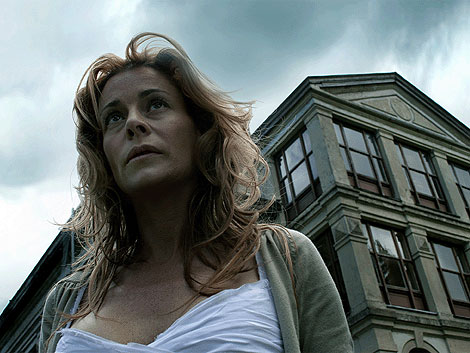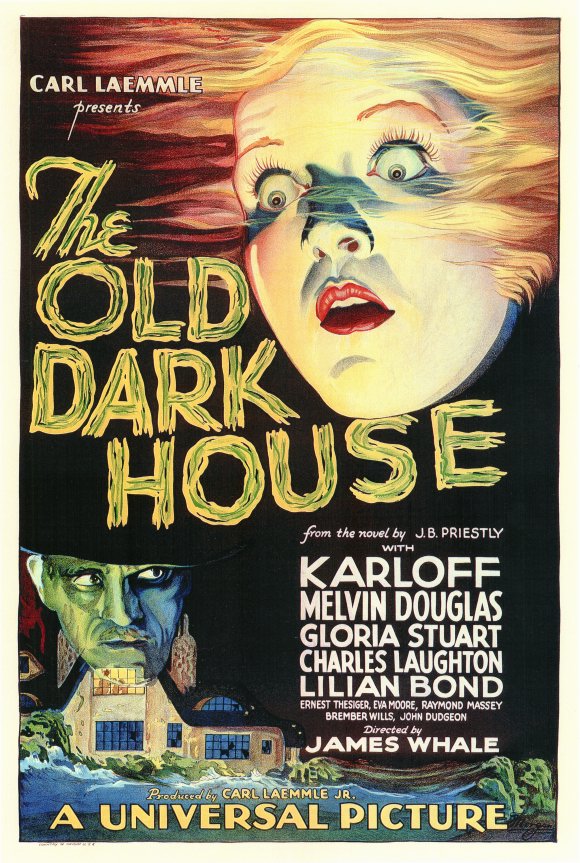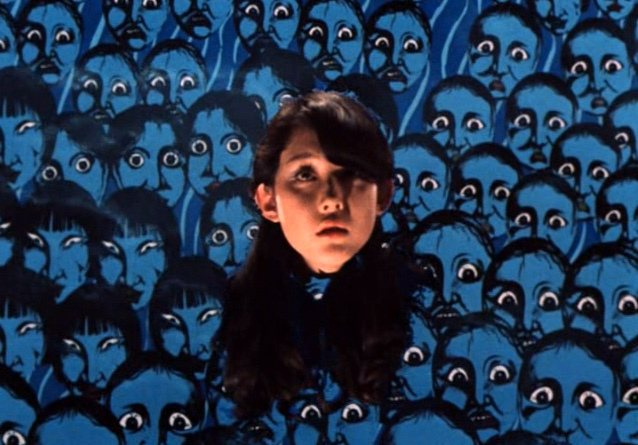This Friday sees the release of James Watkins’ bloodcurdling adaptation of The Woman in Black, produced by the recently resurrected Hammer Films, who have risen like one of their macabre creations to torment us once more. With its old dark house spookiness and “bat out of hell” villainess, the screen incarnation of Eel Marsh House is suitably forbidding, but it’s only the latest in a long of line of diabolical dwellings where you reside at your peril and leave - only if you’re lucky - sanity surrendered and trousers browned. Buyer beware: these are the houses that drip blood.
Every horror film sets foot inside a house or two but for some the focus falls on one abysmal abode. Over the years cinema has provided us with a city’s worth of horrible houses: looming mansions and run-down shacks, an infestation of “squeal” estate.
 These include: the kids' horror Monster House (2006); elegant spookiness of The Orphanage (2007, pictured left); the menacing of a mute in The Spiral Staircase (1945); ferociously comic shack shenanigans in Evil Dead II (1987); all the way to the no-laughing-matter sexual violence and Satanism of Rosemary’s Baby (1968). 'Tis a powerful perversion, to be sure, turning a place of traditional security into a relentless source of threat, where the streets are safer because home is where the horror is. The conceit is as popular as it ever was: along with The Woman in Black we’ve recently seen Don’t Be Afraid of the Dark, Dream House and on TV American Horror Story where episode after episode a family encounter fresh frights.
These include: the kids' horror Monster House (2006); elegant spookiness of The Orphanage (2007, pictured left); the menacing of a mute in The Spiral Staircase (1945); ferociously comic shack shenanigans in Evil Dead II (1987); all the way to the no-laughing-matter sexual violence and Satanism of Rosemary’s Baby (1968). 'Tis a powerful perversion, to be sure, turning a place of traditional security into a relentless source of threat, where the streets are safer because home is where the horror is. The conceit is as popular as it ever was: along with The Woman in Black we’ve recently seen Don’t Be Afraid of the Dark, Dream House and on TV American Horror Story where episode after episode a family encounter fresh frights.
The closest cinematic relations to The Woman in Black are ghost stories where restless ghouls - like the aforementioned’s Jennet Humfrye – stalk the corridors of stately homes. The Innocents (1961, pictured below right) is an awfully beautiful frightener from director Jack Clayton. It sees a stoic governess, Deborah Kerr, attempting to shield two precocious charges against “abominations” from Bly House’s menacing and sexually shameless past.
 In Alejandro Amenábar’s The Others (2001) a histrionic Nicole Kidman and her photosensitive children hide from the light and the mysterious “others” in a house wrapped in fog. In lesser-known spook-fest The Legend of Hell House (John Hough, 1973) a group of specialists enter “the Mount Everest of haunted houses” to investigate the possibility of survival after death. And if this sounds foolhardy it most certainly is: as the name suggests, it’s aggressively hostile and haunted by the spirit of a spectacular sadist.
In Alejandro Amenábar’s The Others (2001) a histrionic Nicole Kidman and her photosensitive children hide from the light and the mysterious “others” in a house wrapped in fog. In lesser-known spook-fest The Legend of Hell House (John Hough, 1973) a group of specialists enter “the Mount Everest of haunted houses” to investigate the possibility of survival after death. And if this sounds foolhardy it most certainly is: as the name suggests, it’s aggressively hostile and haunted by the spirit of a spectacular sadist.
It’s not always ghosts of course. Sometimes these infernal interiors are the harbouring those who are more - if sometimes barely - human. Wes Craven’s The People Under the Stairs (1991) finds a street-smart kid taking on a monstrously cruel couple who keep
their "adopted" (i.e. stolen) cast-offs in their cellar; they find themselves driven to distraction when one of these cruelly rejected and abused children escapes and takes up residence in the walls. The House of the Devil (2009) from director Ti West provides a “devilish” answer to the question - should you ever babysit for an enormous stranger who has no apparent child? And the house of horrors, in seminal slasher The Texas Chainsaw Massacre (Tobe Hooper, 1974), gives us a family dinner you’ll never forget.
 Things need not always be po-faced and sometimes the subject is played more for laughs, as in the case of James Whale’s terrific early entry, The Old Dark House (1932, poster image pictured left), which sees a group of travellers converge on a creepy mansion during a storm, only to find Boris Karloff and Ernest Thesiger amongst the crackpot inhabitants. Needless to say things quickly descend into riotous lunacy. Vincent Price could usually be found onscreen inhabiting some spooky dwelling or other and such is the case with William Castle’s playful House on Haunted Hill (1959) in which Price challenges guests to spend 12 torturous hours in an accursed abode, armed with handguns presented in tiny coffins. The Eighties were bursting at the britches with house-based horror comedy, including such anarchic titles as the already mentioned Evil Dead II and Steve Miner’s 1986 effort, the rather less well remembered but still entertaining House (tagline: “Ding Dong, You’re Dead”), which sees an author misplacing his marbles in his childhood home as he battles a somewhat goofy collection of the undead.
Things need not always be po-faced and sometimes the subject is played more for laughs, as in the case of James Whale’s terrific early entry, The Old Dark House (1932, poster image pictured left), which sees a group of travellers converge on a creepy mansion during a storm, only to find Boris Karloff and Ernest Thesiger amongst the crackpot inhabitants. Needless to say things quickly descend into riotous lunacy. Vincent Price could usually be found onscreen inhabiting some spooky dwelling or other and such is the case with William Castle’s playful House on Haunted Hill (1959) in which Price challenges guests to spend 12 torturous hours in an accursed abode, armed with handguns presented in tiny coffins. The Eighties were bursting at the britches with house-based horror comedy, including such anarchic titles as the already mentioned Evil Dead II and Steve Miner’s 1986 effort, the rather less well remembered but still entertaining House (tagline: “Ding Dong, You’re Dead”), which sees an author misplacing his marbles in his childhood home as he battles a somewhat goofy collection of the undead.
Often the house itself is cast explicitly as the villain: The Haunting (1963), from director Robert Wise, features the demonic Hill House, described as “an evil house from the beginning, a house that was born bad”; Nobuhiko Obayashi’s brilliantly bat-shit Japanese horror Hausu (1977, pictured below right) sees seven schoolgirls slain and consumed in an isolated country mansion (amazingly one is eaten by a piano); and, in Donald Cammell’s sci-fi nightmare Demon Seed (1977) Julie Christie is terrorised by Proteus Four, an experiment in artificial intelligence gone rogue, who seizes charge of her computer-controlled home in order to trap and impregnate (yes, that’s im-preg-nate) her.
 In addition, outré Italian director Mario Bava memorably gave us horrible houses aplenty in his giallos, and last year’s terrifying Uruguayan “one-shot” screamer The Silent House, directed by Gustavo Hernández, proved masterful in its depiction of a sustained threat from a mysterious intruder. Like The Amityville Horror (1979), it’s supposedly based on a true story.
In addition, outré Italian director Mario Bava memorably gave us horrible houses aplenty in his giallos, and last year’s terrifying Uruguayan “one-shot” screamer The Silent House, directed by Gustavo Hernández, proved masterful in its depiction of a sustained threat from a mysterious intruder. Like The Amityville Horror (1979), it’s supposedly based on a true story.
House-based horrors are our domestic fears writ cinematically large and loud: a squeak of the floorboards is taken to a dastardly conclusion; a trip to the bathroom involves the appearance, or threatened appearance of a strange face; home invasion isn’t just paranoia but a hideous reality; and a door slamming shut is unlikely to be the wind. To paraphrase diminutive fiend Wednesday Addams, an inhabitant of one of the most iconic of all horrible houses, in the end what these films teach us is to be afraid, to be very afraid.
Watch a clip from The Woman in Black















Add comment